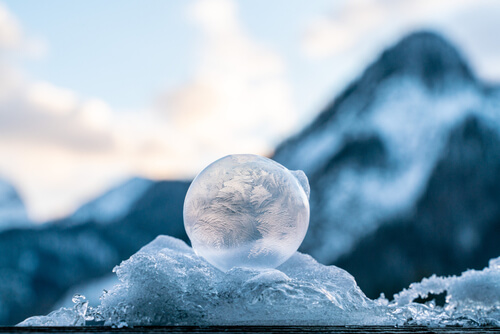Welcome to the fascinating world of ice! From the delicate snowflakes that can grace our winters to the colossal icebergs still floating in our oceans, ice holds a special place in our natural environment. But there’s more to ice than meets the eye.
At Emergency Ice, we aren’t just Dallas and Fort Worth’s ice delivery experts, we are ice enthusiasts! Grab a cozy blanket and a warm beverage, and we’ll explore the chilly wonder of ice science!
The Ice Crystal Symphony
No two snowflakes are alike; their intricate designs have captivated our scientists for centuries. Each snowflake begins as a tiny ice crystal formed around a dust particle in the atmosphere. As the crystal falls through the clouds, it encounters varying temperatures and humidity levels, resulting in its unique shape.
The beautiful symmetry of snowflakes arises from the hexagonal arrangement of water molecules, which form a lattice structure as they freeze. Next time you catch a snowflake on your mitten, observe the delicate symphony of ice crystals!
Mighty Icebergs
As glaciers make their way to the sea, chunks of ice break off and form awe-inspiring icebergs.
Unlike the portable bricks of dry ice we deliver, these floating giants can range in size from small chunks to colossal masses several kilometers in length. Only about 10% of a given iceberg is visible above the water, with the majority submerged beneath the surface. This hidden mass is crucial in regulating ocean currents and influencing the Earth’s climate.
Ice That Glows
In Antarctica and some frozen lakes, you may encounter a mesmerizing phenomenon known as “ice that glows.” Under specific conditions, ice emits a beautiful blue or green light, known as “glacial ice fluorescence.” This intriguing glow is due to algae and microorganisms that produce pigments with fluorescent properties. Witnessing this ethereal glow is a true testament to the wonders of nature.
The Science of Skating
Ice skating is a popular winter pastime, but have you ever wondered why we glide so effortlessly across the ice? A thin layer of liquid water forms on the surface when you apply pressure. The blade of a skate presses down on the ice, melting the top layer and creating a thin film of liquid water that significantly reduces friction. Next time you lace up your skates, remember that the science of physics and ice makes it all possible!
The Mysterious Ice Nine
Ice IX is a unique form of ice that can only exist under extremely high pressures. Nobel Laureate Percy Bridgman first theorized it in the 1930s. Different types of ice, from ice II to ice XIX, have been created in the laboratory at different temperatures and pressures.
Ice IX has a tetragonal crystal structure unlike regular ice’s hexagonal lattice structure. It is not naturally found on Earth but can be synthesized in the laboratory.
Supercooling
Did you know water can stay liquid below its freezing point? This is known as supercooling, which involves carefully controlling the conditions in which water is cooled.
One way to achieve supercooling is by cooling purified water slowly and preventing any disturbances or impurities from entering the system. Distilled water, for example, can be supercooled by chilling it in a clean container without agitation.
When supercooled, water can exist as a liquid at temperatures well below 0 degrees Celsius (32 degrees Fahrenheit). However, the slightest disturbance, or introduction of an ice nucleus like a mote of dust, can cause rapid freezing. Despite being in a supercooled state, water is still seeking to transition into its solid form.
Ice on Other Planets
Ice is not limited to Earth, of course. It exists in various forms on other planets and moons in our solar system.
Mars has polar ice caps composed of water ice and carbon dioxide ice (dry ice). Jupiter’s moon Europa is thought to have a subsurface ocean covered by a layer of ice.
Melting Ice and Sea Level Rise
The melting ice of glaciers and polar ice caps, driven by global temperature rise, is a critical concern with far-reaching implications. As the Earth’s average temperature increases due to human activities like burning fossil fuels and deforestation, the world’s ice reservoirs are experiencing accelerated melting rates. This directly impacts rising sea levels, posing significant challenges for coastal communities and ecosystems worldwide. Understanding and addressing climate change is of utmost importance in mitigating these effects.
Addressing climate change is crucial to mitigate the impacts of rising sea levels. Reducing greenhouse gas emissions, transitioning to renewable energy sources, promoting sustainable practices and implementing measures to adapt to changing coastal conditions are vital strategies.
The importance of understanding and addressing climate change cannot be overstated. Scientific research and global collaboration play pivotal roles in assessing the challenges ahead and developing effective strategies to deal with them. Acknowledging the impacts of melting ice, we can work toward a more sustainable and resilient future for coastal communities and the environment as a whole.
Emergency Ice Is Your Ice Source in Times of Need
The science of ice is a captivating realm filled with wonders and surprises. From snowflakes’ intricate beauty to icebergs’ immense power, ice continues to astound us with its unique properties. The science of ice is a testament to the beauty and complexity of our natural world.
Contact us to learn more about how we provide reliable and efficient ice solutions for emergencies, events, or everyday needs.
Experience the convenience of our premium ice delivery services and embrace the power of ice in keeping things cool. Trust EmergencyIce.com to be your partner in handling the chilling demands of any situation — and get ready to experience exceptional ice service today!

